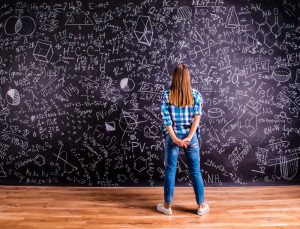This post is adapted from a Parent Information Session run by CHOOSEMATHS Outreach Officer Cassandra Lowry.
How much maths do you use in your daily life?
For many of us, our initial responses to these questions may be “No” and “Not much,” yet when we think about it maths is something that we all use every day, although we may not realise it.
The problem is that the maths we do every day has become so familiar to us that we may not even see it as maths anymore. One of the biggest areas of maths we take for granted is estimation. We use estimation in almost everything we do, from making a cup of tea and cooking food, to having a shower and crossing the road These simple daily tasks and many more all include elements of mathematics.
So, what has happened? Why is there a disconnect between the maths we do every day and the perception surrounding the maths that is done inside the classroom?
At a Kinder Transition meeting at Scone Public School, I spoke to parents about this idea. As a general groan reverberated around the room at the mere mention of maths in school, it seemed that parents present did not see themselves as mathematicians, with many going further to suggest that they “hated maths at school”.
In some ways, this reaction is not surprising. For many of us, the maths that we may remember from school, is no doubt the more challenging maths from our senior secondary years. Complicated formulas and pages of calculations ensured that our final experience of mathematics in school left many of us feeling anxious and confused.
Hope is not lost. The maths we remember from school is not the maths we learnt about in our first years of school. Nor is it the maths currently being explored by students today in the classroom.
Students in their first years of school learn about numbers, counting, shapes and location. They order objects and collections, and create and continue patterns. They investigate problems, make predictions, use trial and error and talk about their discoveries.
As parents we need to be thinking less about the drilling our child on their “times tables facts” and more about exploring the maths in our everyday lives. This is exactly what my talk with parents, “Finding the Maths” was all about. Rather than purchasing a special book, program or application we just need to look for the maths around us.
We can find maths in books, in the kitchen, in the bedroom, in the bathroom, outside, down the park, in the street, in the playground and walking around the shop. Activities that involve time, money, ordering, location words, going for walks, following directions, counting collections, estimating size, looking for patterns, sorting objects into categories, playing card and board games, using construction materials, building with blocks and completing jigsaws; all involve elements of mathematics.
There is a quote, “If we change the way we look at things, the things we look at change”. The challenge for parents is not to share our anxieties about the maths we remember (or are trying to forget) from secondary school. The challenge is to realise that the maths we take for granted, the maths skills we use every day, are the very tasks that can help establish an inquisitive approach to mathematics and lead to a love of maths with our children.
We hope that the following activities help you and your child experience the maths that is around us all.




